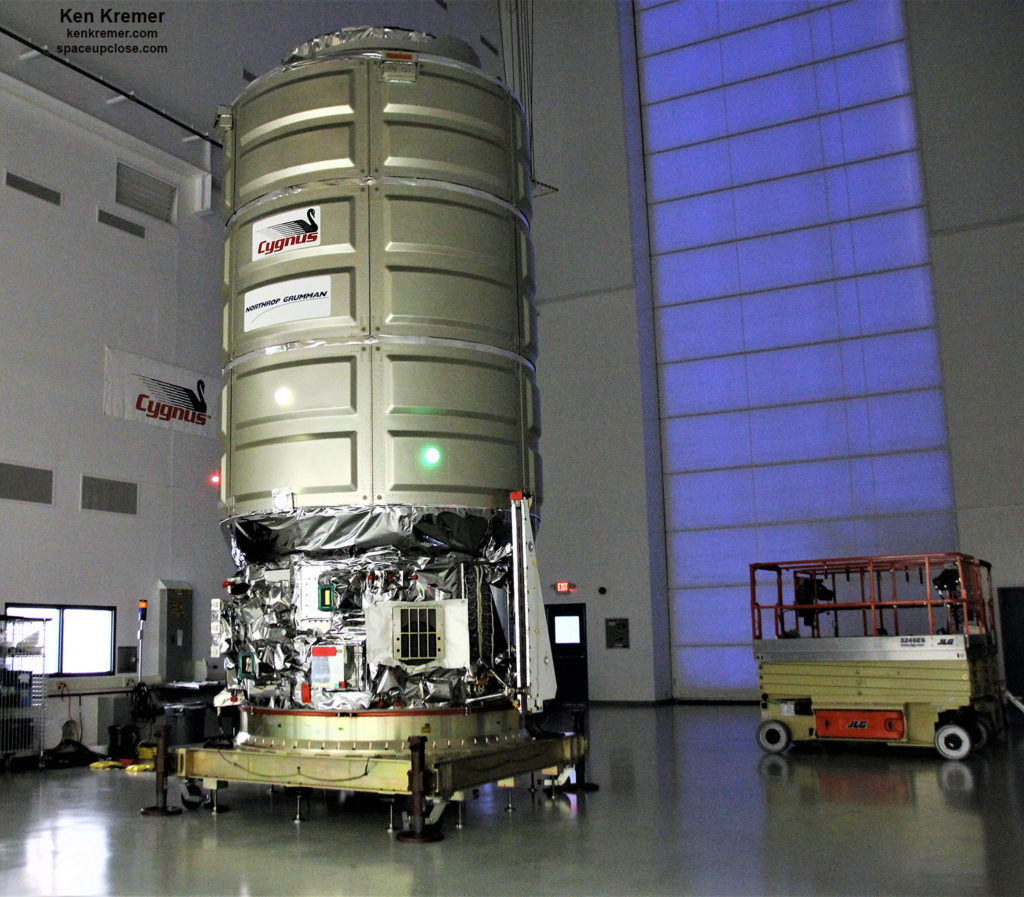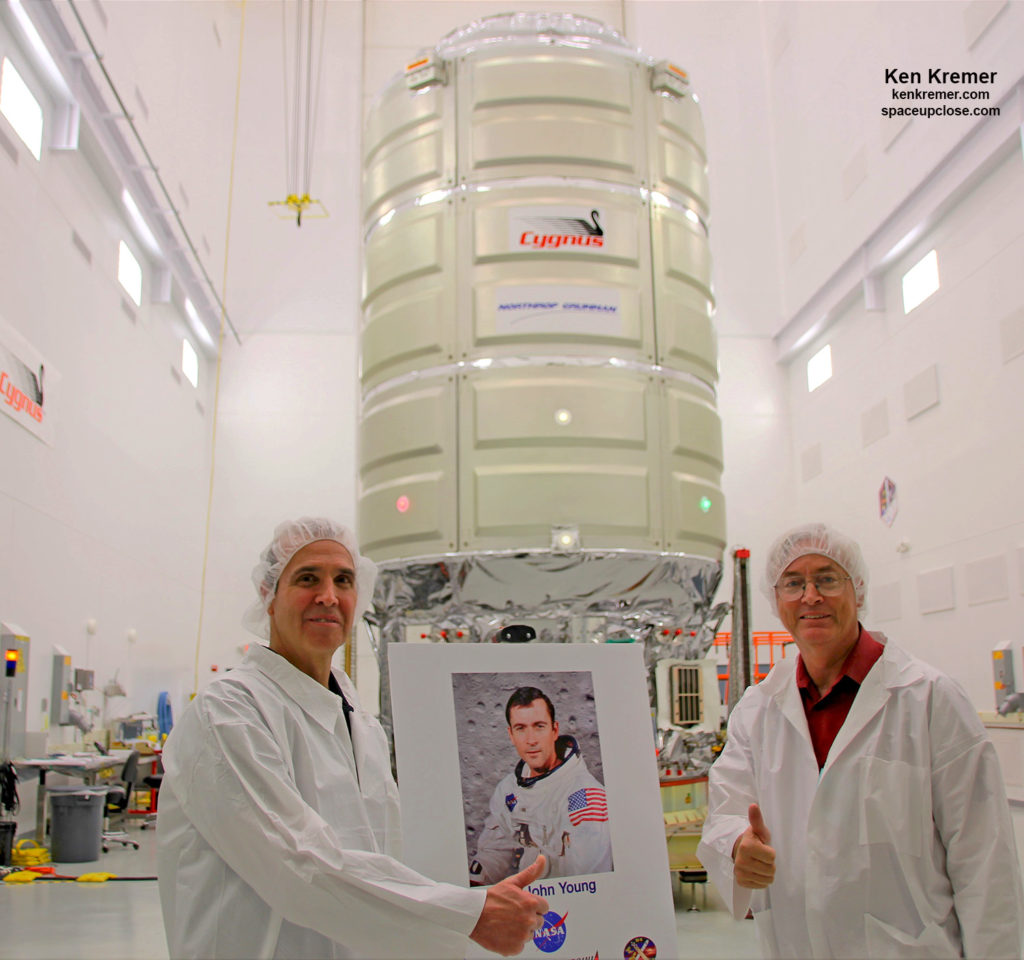NASA WALLOPS
FLIGHT FACILITY, VA – The next Cygnus spacecraft flying
critical American science experiments and cargo bound for the International
Space Station (ISS) has been named in honor of John Young – one of NASA’s & America’s most
renowned astronauts who became the 9th human to walk on the Moon
during the Apollo 16 lunar landing mission in 1972 and commanded the first
Space Shuttle mission in 1981.
The Cygnus NG-10 cargo freighter, built by Northrop Grumman Corporation, was christened the S.S.
John Young – in memory of John Young who was NASA’s longest serving astronaut
and passed away earlier this year in January at age 87.
and station hardware and crew supplies to the trio of astronauts and cosmonauts
living aboard the orbiting science outpost with blastoff atop the 2 stage
Antares rocket scheduled in approximately
three weeks’ time on Nov. 15 on Northrop Grumman’s 10th station
resupply cargo mission for NASA.
Among the research items on board will be a 3D
printer/fabricator to aid NASA’s Deep Space exploration efforts.
Mastracchio, former NASA astronaut and current senior director of
Commercial Resupply Services for Northrop Grumman, on Wednesday, Oct. 24,
at a naming ceremony held with Cygnus inside the H-100 cleanroom High Bay processing
facility at NASA’s Wallops Flight Facility on the Virginia shore – with NASA, company officials and news
media in attendance including Space UpClose.
Enjoy my exclusive Space
UpClose gallery of Cygnus & Antares photos herein.
“We are thrilled to announce that the Cygnus
spacecraft for our 10th operational cargo resupply
mission launch to the International Space Station is named in honor of John
Young – one of the legends of space travel and one of my personal heroes,” Mastracchio said. Young was an accomplished naval
officer, test pilot & NASA astronaut.
“We have many rich traditions in the space business
and I’ve been part of the Space Shuttle and Soyuz launches.”
“Northrop Grumman has
its own traditions and we traditionally name each Cygnus spacecraft in honor of
astronauts or heroes in the space industry and individuals who contributed to
the United States’ commercial space program. Young’s bravery and record of NASA
“firsts” pushed the boundaries of human space exploration, making him an ideal
honoree for the NG-10 Mission.”
“Over the past year we
named vehicles after Gene Cernan, Apollo 17 moonwalker, and JR Thompson, who
played key roles at both NASA and as the founder of Orbital Sciences.”
“John was selected in
1962 as part of the second group of NASA astronauts. He flew on the first
Gemini, Mission 3 with Gus Grissom. Later he flew on a second Gemini mission – Gemini
10. He flew two Apollo missions, first on Apollo 10 where they practiced the
actual moon landing. And then on the Apollo 16 landing mission where he conducted
three EVA’s and drove the lunar rover across the Moon’s surface.”
“Young flew the first space
shuttle on STS-1 and finished up his spaceflight career with STS-9.”
“John was a great
astronaut and a great person! And I got to work with John Young for many years.”
“I am very excited that
we are honoring John Young here,” Mastracchio stated with great pride at the
Cygnus cleanroom dedication event at NASA Wallops on Oct. 24.
is the only human to have flown on NASA’s project Gemini, Apollo and Space
Shuttle spacecraft. He also launched a 7th time from the Moon departing
on the Apollo 16 lunar module to close out NASA’s 5th lunar landing
mission.
He logged over 865 hours in space altogether on Gemini 3 (1st
Gemini), Gemini 10, Apollo 10, Apollo 16 (lunar landing), STS-1 (1st
space shuttle) and finally STS-9; totaling 34 days 19 hours 39 minutes.
“He is the only person to go into space as part
of the Gemini, Apollo and space shuttle programs and was the first to fly into
space six times — or seven times, when counting his liftoff from the Moon
during Apollo 16,” NASA said in a statement mourning his passing in January.
Young was active as a NASA astronaut for over 42 years of
active service.
“Young
was a pioneer in the field of human spaceflight who positioned future
astronauts to live and work at the International Space Station,” said Northrop
Grumman.
S.S. John Young, is scheduled
to launch aboard the company’s upgraded Antares 230 version rocket on Thursday
November 15 at 4:50 a.m. EDT from seaside pad 0A at NASA’s
Wallops Flight Facility in Virginia bound for the International Space Station.
at this time,” Kurt Eberly, Antares
program manager Northrop Grumman VP, told Space UpClose in an interview during the Cygnus
dedication event at NASA Wallops on Oct. 24.
“Of course it always depends on NASA’s requirements which
can change.”
“Overall this launch [of NG-10] will be very similar to the
last one OA-9 [when the aerospace company was still independently operating as
Orbital ATK] in May of this year 2018.”
“OA-9 was very successful,” said Eberly. See my launch photo below.
result of the recent Soyuz launch abort failure of the MS-10 crew who landed
safely after an emergency in flight abort occurred just 2 minutes after
liftoff on Oct. 11.
“We have started loading some of the cargo on Cygnus,”
former NASA astronaut Rick Mastracchio told
me in a clean room interview.
“There will be some changes in the manifest from what had
been planned prior to the Soyuz incident.”
“But NASA is still in the process of deciding. We can add
cargo as late as about 4 days prior to liftoff with the current Cygnus
configuration,” Mastracchio explained to me.
The next step was placing Cygnus in a protective crate and wheeled
transporter and moving it vertically to the V-55 fueling facility building.
Then it will be transported on Nov. 1 to the Horizontal Integration Facility
(HIF) for encapsulation in the payload fairing and integration with the Antares
rocket.
Cygnus will be loaded with cargo up to 3,450 kg (7,605 lb.)
comprising science experiments, research gear,
food, water, spare parts, crew supplies and vehicle hardware to support the Expedition 57 and 58 crews
vital equipment, supplies and scientific equipment to the space station as part
of Northrop Grumman’s Commercial Resupply Services-1 (CRS-1) contract with NASA– totaling 11 cargo flights.
NG-10 is the next to
last followed by NG-11 next spring, said Eberly.
“Northrop Grumman also
has been awarded the follow on CRS-2 contract from NASA comprising at least 6
more cargo missions.”
 |
|
Launch of Orbital ATK OA-9 Antares/Cygnus to the ISS on 21 May 2018 from NASA Wallops, VA. Credit: Ken Kremer/kenkremer.com/SpaceUpClose.com
|
To date, Cygnus
spacecraft have delivered more than 23,000 kilograms of cargo to the
International Space Station, and removed 17,000 kilograms of disposable
cargo.
prior Cygnus cargo freighter was successfully launched by an Antares 230
vehicle from Wallops on May 21, 2018 on the Orbital ATK OA-9 resupply mission
for NASA before the company merged with Northrop Grumman.
 |
| Pre-Launch view of Orbital ATK OA-9 Antares/Cygnus mission to the ISS on 21 May 2018 from NASA Wallops, VA. Credit: Ken Kremer/kenkremer.com/SpaceUpClose.com |
Watch for Ken’s
continuing onsite coverage of NASA, SpaceX, ULA, Boeing, Lockheed Martin,
Orbital ATK and more space and mission reports direct from the Kennedy Space
Center, Cape Canaveral Air Force Station, Florida and Wallops Flight Facility,
Virginia.
Stay tuned here for Ken’s continuing Earth and Planetary science
and human spaceflight news: www.kenkremer.com –www.spaceupclose.com –
twitter @ken_kremer – email: ken at kenkremer.com
scientist and journalist based in the KSC area.
Ken’s photos are for sale and he is available for lectures and outreach events








